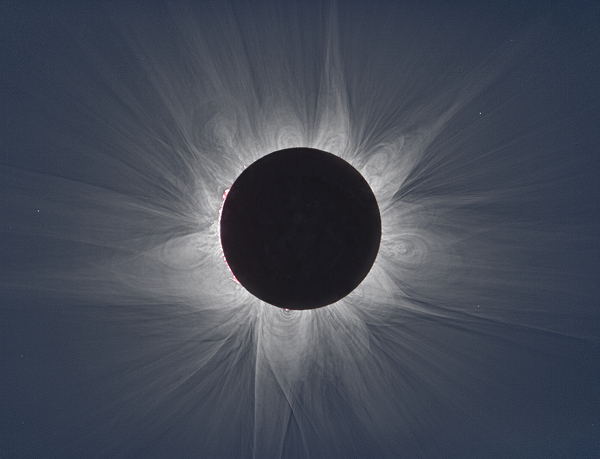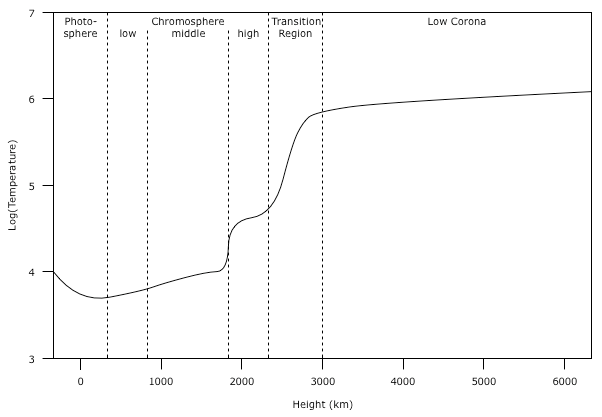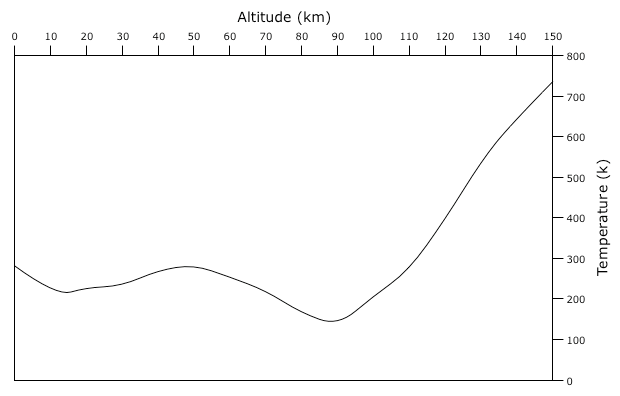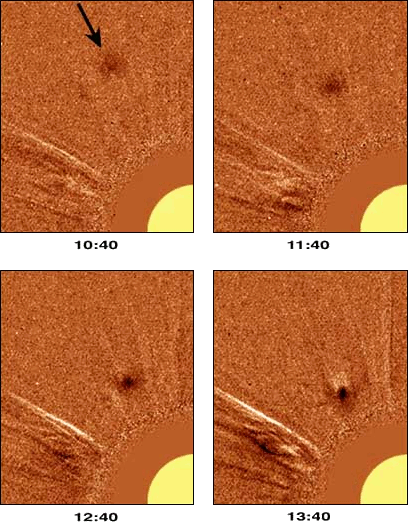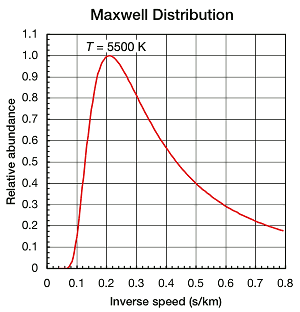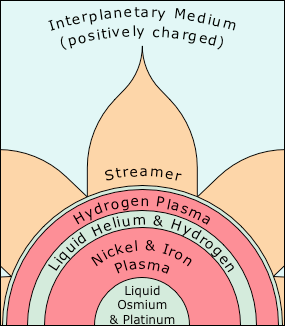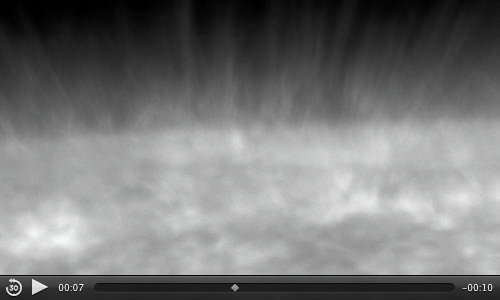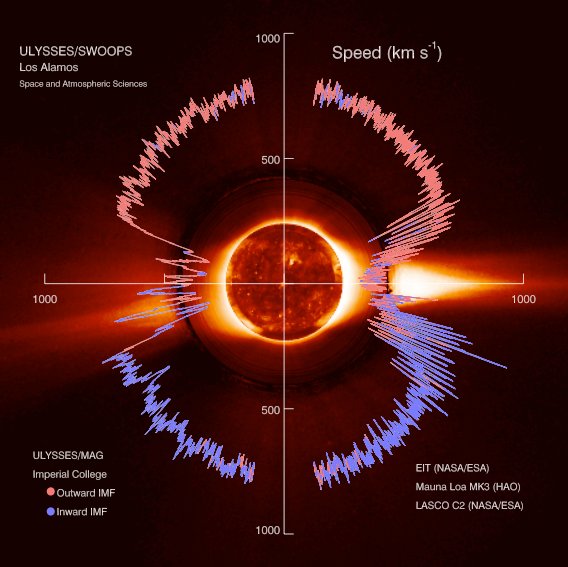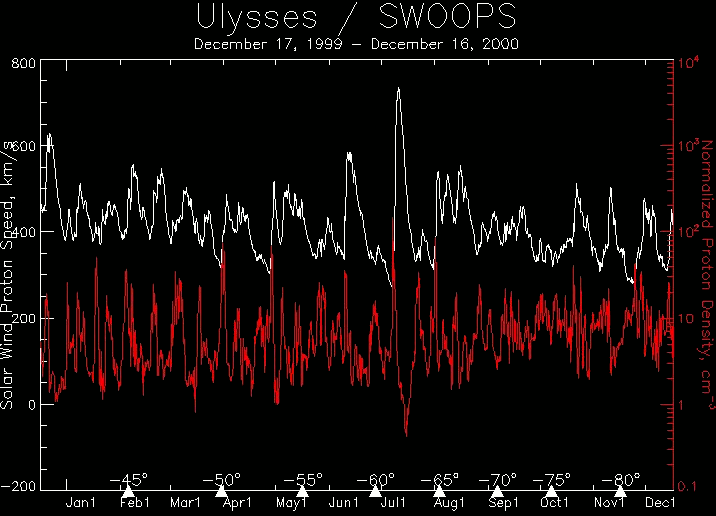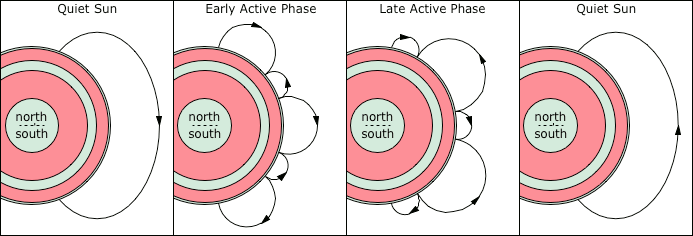© Charles ChandlerAbove the visible edge of the Sun is a ~3 Mm layer known as the chromosphere, and above that is the corona, which is visible if the Sun is fully eclipsed, either naturally, or with a human-made obstruction of the right size in front of the camera. (See Figure 1.)Figure 1. An abundance of helmet streamers in all directions at the sunspot maximum, courtesy Constantine Emmanouilidi.Some consider the corona to be the most mysterious aspect of all. Temperatures measured by the degree of ionization exceed 1 MK. This would seem to be a violation of the 2nd law of thermodynamics, which predicts that the temperature should fall off with the square of the distance from the source of the heat. But after a small decrease in the first .25 Mm above the surface, the temperature levels off, and then rises, with sharp increases in the upper chromosphere and in the transition region, ultimately achieving over 1 MK in the corona.1 (See Figure 2.)At first blush we might think that this is just typical behavior for the atmosphere of a celestial body. The Earth's thermosphere reaches a temperature of 1,700 K without any help from surface heating. (See Figure 3.) In the near perfect vacuum of space, particles achieve extreme speeds, and when drawn in by the Earth's gravity, the initial particle collisions are extremely high-energy events.The Sun's mass is 333,000 times greater than the Earth's. If we scale the temperature by the mass ratio, look at what we get...1,700 K × 333,000 = 566,100,000 KSo it's possible that the Sun's corona achieves temperatures into the millions of K just on the basis of high-energy collisions from falling particles.2 And there is actually direct evidence of particles being accelerated inward, by the force of gravity and/or the electric field.3,4But on closer inspection, it isn't that simple. Videos of the streamers show an apparent outward flow. So there are opposing inward and outward forces. Some scientists believe that the outward force is simply hydrostatic pressure in superheated plasma. But there are three major problems with that.First, the speed of the solar wind is in the range of 300~800 km/s near the Sun. More than 10 R⊙ away, the speed stabilizes at roughly 400 km/s. Yet the 5525 K blackbody temperature is insufficient to accelerate plasma to greater than 300 km/s. The translational velocity of a helium atom at 5500 K is merely 4.78 km/s (see Figure 5). The rate at which a parcel of plasma can expand is at most .62 of the velocity of the atoms (i.e., the speed of sound). Hence the peak speed just from thermal expansion would be 2.96 km/s, less than 1/100 the speed of the solar wind. This led some researchers to concentrate on the effects of higher temperatures in the corona as the motivating force, where the temperature is nearly 3 orders of magnitude higher. But the peak thermal speed of helium is just 12 km/s. It's twice as high for hydrogen, but that still doesn't get into the solar wind range. Furthermore, if the heat is created by high-energy collisions of falling particles, they will not be accelerated back out. Rather, as the collisions create heat and the hydrostatic pressure increases, the particles will slow down and stop, thereafter remaining in a gravitational-hydrostatic equilibrium.Second, the solar escape velocity is 618 km/s. This begs the question of how the bulk of the particles get free of the Sun's gravity, moving as slow as 400 km/s.Third, the velocity of the particles increases with distance from the surface of the Sun, up to a peak at about 10 R⊙. If the source of the energy was the Sun itself, the velocity would be greatest at the surface, and would decrease with time due to the forces of gravity and friction with in-falling particles.Hence there is no configuration of gravitational, thermal, and inertial forces that can account for the solar wind.The only remaining possibility is that another force is at work, which can only be electromagnetism. This force can easily accelerate particles to such velocities. The magnetic fields in the corona are extremely weak, but the electric field between the Sun and the interplanetary medium has been estimated between 600 MV and 3 GV.5,6,7:6,8,9 So we'll focus on the electric force.Figure 6. The charged layers of the Sun & the heliosphere (blue = positive, red = negative, and orange = neutral, current conducting plasma).Studies of the solar wind near the Earth have found roughly equal quantities of positive ions and free electrons, both moving outward from the Sun. From this we get a basic concept of the "wind" as a neutrally charged particle stream starting at the Sun. But if the electric force is responsible, we have to acknowledge that in an electric field, positive ions go one way and electrons go the other. With the dominant charge near the surface of the Sun being negative, and with the plasma in the interplanetary medium being predominantly positive, electrons will be expelled from the Sun, while positive ions will be pulled inward by gravity (to the limits of hydrostatic pressure). The bi-directional motion of particles establishes the energy source in the corona. High-energy collisions between electrons and positive ions moving in different directions generate the extreme temperatures in the corona, as well as the distinctive photons.10:31 (See Figure 6.)If the electric force is pulling positive charges toward the Sun, what then causes the wind away from the Sun that has been measured near the Earth? The answer might be that ions further from the Sun, and therefore experiencing less attraction, are also being bombarded by high-energy electrons that impart outward Newtonian forces. Once neutralized by the electrons, the electric field is no longer a factor, and at 10 R⊙, 400 km/s velocities are well above the escape velocity. In other words, the out-flowing electrons drag the positive ions along with them. The apparent outward flow near the Sun might actually be just wafts of electrons passing through plasma that is only beginning to get accelerated away from the Sun.Note that the net charge in the corona appears to be zero. Some have concluded that this proves that the electric force cannot be present, as it requires a charge separation. But there is a difference between electrostatics and electrodynamics. If we were to measure the net charge in a current-carrying wire, we'd find it to be zero. It's the electrostatic potential from one end of the wire to the other that produces the current through the wire, not a charge separation in the wire. If electrons are flowing through plasma in the corona, the net charge of the corona might be zero, while the proof of an electric current is the ohmic heating, the EM radiation, and the observable bi-directional flows in the corona.Also note that the top of the negative layer inside the Sun is a current divider. Below that level, electrons are pulled down to the ionized hydrogen & helium. Above that level, they are pulled away from the Sun. This accounts for the acceleration that we see in the corona. The further the electrons get from the current divider, the more unambiguous the field, and hence the greater the force acting on them. It also accounts from the broadly distributed flow of current, as in Figure 7. While currents through a low-density medium are easily pinched into discrete channels (e.g., terrestrial lightning), the currents at the solar surface emanate from a wide area. Only slow-moving electrons, dispersed by electrostatic repulsion in the cathode, would emerge from such a broad area, and only get pinched into discrete channels as they move further from the cathode.Figure 7. Superheated plasma in the chromosphere, 2006-11-22, courtesy Scott McIntosh, Bart De Pontieu, Viggo Hansteen and Karel Schrijver. (Click this to watch the movie.)Within this framework, we can now ratchet up the specificity. It was previously stated that the speed of the wind is in the range of 300~800 km/s, but there isn't much of a continuum within that range. There are actually two distinct groups: the slow wind (at ~300 km/s), and the fast wind (at ~800 km/s). The slow wind typically emanates from the equatorial band during the sunspot minimum, or at all latitudes during the sunspot maximum (as in Figure 1). The visible aspect of the slow wind is the helmet streamers. The fast wind averages 800 km/s, and is characteristic of higher latitudes during the sunspot minimum, in the so-called coronal holes.Figure 8. Fast and slow solar winds at the solar minimum, as measured by a variety of means, courtesy NASA.The reason for the much greater luminosity of the streamers is that the positive ion density is much greater, resulting in more electron uptake and bremsstrahlung radiation. Ion density also modulates the wind speed, since it presents electrical resistance. Thus the wafts of electrons struggle through the streamers at 300 km/s, while they zip through the coronal holes at 800 km/s. The inverse relationship between ion density and wind speed also holds for temporal variations. (See Figure 9.)Figure 9. A comparison of the speed of the solar wind (in white) to the density of protons (in red), courtesy LANL.The last question concerns why the ion density is so variable. The answer might be that the electron drift velocity varies for its own reasons. Where it is fast, electron drag evacuates the ions, and where it is slow, more ions linger. So what could make such a difference in electron drift velocity?There is no reason to believe that the solar~heliospheric electric field is any different in the equatorial versus the polar direction. The positive charge in the heliosphere should be well distributed by electrostatic pressure, and the same should be true of negative charges inside the Sun, so the field should be radially symmetrical. What else is there?This is easiest to answer if we simply constrain the choices to forces that originate from inside the Sun, which vary with the solar cycle, and which are operative in the corona. That pretty much narrows it down to the Sun's overall magnetic field. (See Figure 10. See the Cycles section for a description of the magnetomotive forces.)During the quite phase, equatorial currents will be damped by the Lorentz force as they attempt to cross perpendicular magnetic lines. Polar currents do not have this problem, as the lines of force are normal to the surface. In other words, the Sun's magnetic field encourages polar currents in the same way that the Earth's magnetic field causes the aurora. So during the quiet phase, the electron velocity is higher at the poles. In the tenuous solar atmosphere, electron drag is sufficient to evacuate the ions, creating coronal holes. The reduced ion density reduces the electrical resistance, further encouraging the currents.During the active phase, the overall field is more complex. Wherever the magnetic field lines are normal to the surface, the winds will be fast and more transparent. Wherever the lines are parallel to the surface, the winds will be slow and luminous.
1. Erdélyi, R.; Ballai, I. (2007): Heating of the solar and stellar coronae: a review. Astronomische Nachrichten, 328 (8): 726-733 ⇧
2. Smid, T. (2010): Gravitational Energy of the Sun explains "Coronal Heating" ⇧
3. Sheeley, N. R., Jr.; Wang, Y. (2001): Coronal Inflows and Sector Magnetism. The Astrophysical Journal Letters, 562 (1): L107 ⇧
4. Fleck, B. (2001): SOHO's latest surprise: Gas near the Sun heading the wrong way. ⇧
5. Birkeland, K. (1908): The Norwegian aurora polaris expedition, 1902-1903. H. Aschehoug & Co. ⇧
6. Alfvén, H. (1990): Cosmology in the plasma universe - an introductory exposition. IEEE Transactions on Plasma Science, 18: 5-10 ⇧
7. Alfvén, H. (1941): Remarks on the Rotation of a Magnetized Sphere with Application to Solar Radiation. Arkiv för Matematik, Astronomi och Fysik, 28A (6): 1-9 ⇧
8. Neslušan, L. (2001): On the global electrostatic charge of stars. Astronomy and Astrophysics, 372: 913-915 ⇧
9. Alfvén, H. (1949): On the Solar Origin of Cosmic Radiation. Physics Reviews, 75 (11): 1732 ⇧
10. Swartz, M. et al. (1999): The SERTS97 Rocket Experiment to Study Activity on the Sun: Flight 36.167GS on 1997 November 18. NASA, 1999-208640 ⇧











